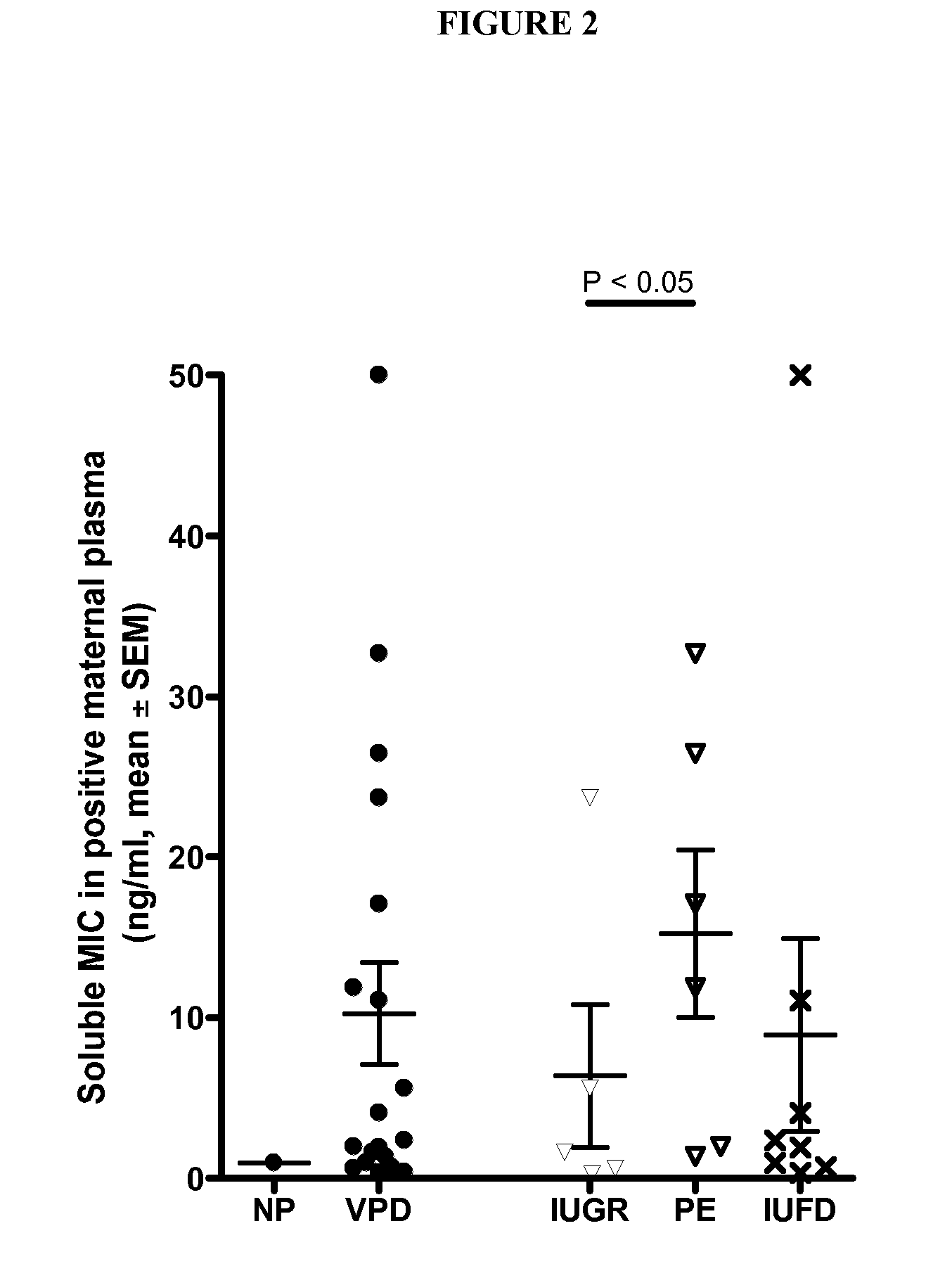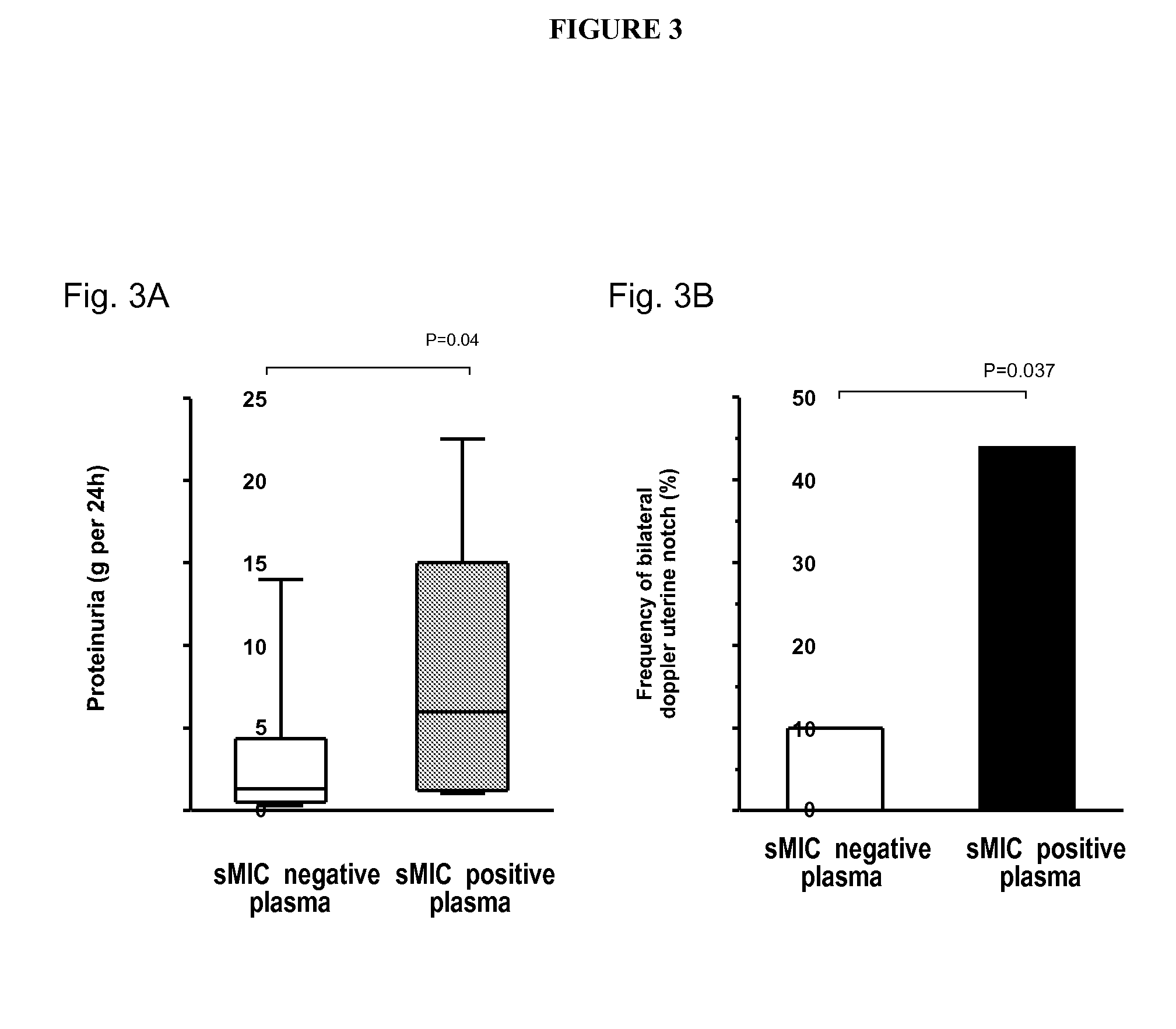Biomarker for the Medicine and the Biology of the Reproduction
a biomarker and reproduction technology, applied in the field of predictive markers, can solve the problems of increasing the risk of clinical complications, difficult access to ivf treatment for most infertile couples, and difficult to find infertility treatment, so as to improve counselling or management
- Summary
- Abstract
- Description
- Claims
- Application Information
AI Technical Summary
Benefits of technology
Problems solved by technology
Method used
Image
Examples
example 1
Serum Levels of Soluble MIC are Predictive Markers of Implantation Failure and Successful Term Pregnancies Following In Vitro Fertilization
[0071]Uterine NK (uNK) are the predominant lymphoid cell population found at the embryo implantation site and progressively disappear after mid-gestation. Innate immune mechanisms operating in the mother are thus thought to have a strong influence in acceptance of the semi-allogeneic foetus. In particular, uNK receptors recognize paternal / trophoblast ligands, which prevent foetal attack by the maternal immune system.
[0072]Presence of soluble HLA-G, a known NK inhibitory ligand usually expressed at the fetomaternal interface, in embryo supernatants, has been correlated to higher embryo implantation rates after in vitro fertilization (IVF) (Fuzzi et al., 2002; Warner et al., 2004). Interaction between maternal killer immunoglobulin receptors (KIR) on uNK and foetal HLA-C also influences reproductive success (Hiby et al., 2004; Parham, 2004; Wu et a...
example 2
Soluble MIC is Found at Higher Frequencies in Plasma of Women Vascular Pregnancy Diseases
[0099]Pregnancy creates a unique situation in which extensive angiogenesis and establishment of maternal immune tolerance allow successful fetal and placental development. Cross talk between trophoblast fetal cells and maternal immune cells regulate early pregnancy placental development, vasculogenesis and immune tolerance of the fetus. Inadequate placentation leads to vascular pregnancy diseases (VPD) that include preeclampsia (PE), intrauterine growth retardation (IUGR) and recurrent pregnancy loss, which represent a leading cause of fetomaternal morbidity and mortality. Preeclampsia is characterized by hypertension and proteinuria after 20 weeks of gestation. Despite recent advances in understanding how inadequate placental vascularization (incomplete spiral artery remodeling) may lead to vascular pregnancy diseases, their prognosis remains severe, and placental removal is still the only trea...
example 2a
Materials and Methods
[0100]Subjects
[0101]Soluble MIC plasma levels were evaluated in 49 women that experienced vascular pregnancy diseases (VPD) that include vascular Intrauterine growth retardation (IUGR), Preeclampsia (PE), or intra uterine foetal death (IUFD) and compared to a control group of plasma from 53 women with normal ongoing pregnancies matched for pregnancy term (mean 29 weeks).
[0102]Methods
[0103]PE was defined as a diastolic arterial blood pressure greater than 90 mm Hg, and a systolic blood pressure greater than 140 mm Hg, associated with proteinuria (more than 300 mg / 24 h). In addition, severe maternal complications associated with increased risk of adverse outcome for both mother and fetus were reported, particularly association with HELLP syndrome (H=hemolysis; EL=elevated liver enzymes; and LP=low platelets) (Weinstein et al., 2005) and oliguria that leads to renal failure.
[0104]Vascular IUGR was defined as ultrasonographic measurement th percentile for gestationa...
PUM
| Property | Measurement | Unit |
|---|---|---|
| thickness | aaaaa | aaaaa |
| diameter | aaaaa | aaaaa |
| systolic blood pressure | aaaaa | aaaaa |
Abstract
Description
Claims
Application Information
 Login to View More
Login to View More - R&D
- Intellectual Property
- Life Sciences
- Materials
- Tech Scout
- Unparalleled Data Quality
- Higher Quality Content
- 60% Fewer Hallucinations
Browse by: Latest US Patents, China's latest patents, Technical Efficacy Thesaurus, Application Domain, Technology Topic, Popular Technical Reports.
© 2025 PatSnap. All rights reserved.Legal|Privacy policy|Modern Slavery Act Transparency Statement|Sitemap|About US| Contact US: help@patsnap.com



